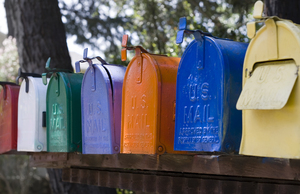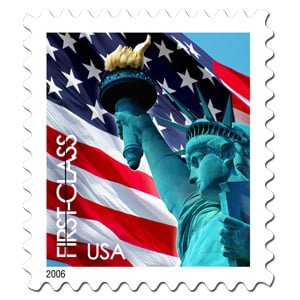The Forever Stamp, first mentioned to the public as a possibility back in 2006, now has a release date of April 12th, 2007. This USPS stamp will alleviate the need to purchase the two and three cent stamps that are often required after postal rates increase. The most recent USPS postal rate increase occurred in January of 2006 when rates on a first-class stamp rose from .37¢ to .39¢. Now, USPS has announced that rates will increase again in May of 2007 to a rate of .41¢ per stamp. Furthermore, USPS has announced that rate increases could likely become a yearly occurrence.
Enter the Forever Stamp. This stamp will be sold at the same rate as a first-class stamp — whatever the rate is at the time of its purchase. It is then good forever, regardless of how many rate increases pass before you use them. So, for example, if a person buys a roll of Forever Stamps in April at .37¢ each, those stamps will still be good — no .02¢ stamp required — in May when rates increase to .41¢ per stamp.
Furthermore, with talk of yearly postal rate increases on the horizon, the Forever Stamp could potentially gain value rapidly. This has left snail mailers all over the country asking the same question: is it worth shelling out the extra money now and buying the Forever Stamp in bulk? To make that decision, you first have to consider the benefits and disadvantages of buying the Forever Stamp in bulk.
Benefits
The potential of the Forever Stamp to gain value:
At the least, Forever Stamps bought in April will be worth .02¢ more when rates increase in May. This represents a gain in value of .40¢ per book of stamps and $2.00 per roll. While $2.00 is something, it’s hardly enticing enough to send you to the post office in April to purchase the Forever Stamp in mass quantities. No, the real value of the Forever Stamp would come after saving it for several years.
There are two ways to estimate the potential rise in value of the Forever Stamp. This first is to look at prior postal rate increases. On March 2nd, 1974, the rate for a first-class postage stamp rose from .08¢ to .10¢. Now, in 2007, a first-class postage stamp is .39¢. That’s an increase of .29¢ in 33 years. If you imagine that rates will increase another .29¢ in the next 33 years, the Forever Stamp will be worth .68¢ in 2040. This is an amount that does not consider inflation of the dollar.
The other way to estimate the potential value of the Forever Stamp is to pose yearly postal rate increases. If stamps rise only .01¢ each year for the next 33 years, then, in 2040, a first-class postage stamp will cost .72¢. If they increase .02¢ each year for the next 33 years, then, in 2040, a first-class postage stamp will cost $1.05. This means that a Forever Stamp bought in April of 2007 will be worth nearly three times its original cost in 2040. A book of Forever Stamps will have risen in value $13.20, and a roll of Forever Stamps will have risen in value $66.
Saving a Forever Stamp is like saving a bond:
If you’ve ever browsed through the gift certificate section on eBay, you know that people are happy to buy girt certificates for just a few dollars less than their value. The same principal could work for Forever Stamps in the future. Say you go out to the pose office and but 10 rolls of Forever Stamps. In 2040, you’re ready to sell them on eBay. If a first-class postage stamp then costs $1.05, and you choose to sell your Forever Stamps for only $1.00 each, you could return a profit of $610. Imagine if you made an even greater investment.
It represents huge savings for businesses:
If you send out 1,000 pieces of mail a month from your business, bulk purchases of the Forever Stamp in April of 2007 could save you hundreds or thousands of dollars in the future. The most obvious example is to imagine how much you’ll save by the end of 2007. In April, you buy enough Forever Stamps to last you for the rest of the year. Then, in May, stamp rates increase .02¢. This means that you’re saving .02¢ on every letter you send from May to December. This means that at the end of the year you will have saved $160. A company that sends out 10,000 pieces of first-class mail a month will have saved $1,060 by the end of the year. And so on.
Disadvantages
We’re entering the Internet age:
I rarely ever use stamps. My bills are automatically deducted from my bank account, I can send electronic checks online to anyone for free, and I can’t remember the last time I wrote a friend through a medium other than email. A book of stamps generally last me six months or more. The benefit of buying a roll of Forever Stamps for someone like me is that they could potentially last forever. The disadvantage of this is that it could potentially void most of the previously-listed benefits. As the non-computer-using population dies off, the number of people paying all of their bills and conducting all of their correspondence online will increase. This means that, potentially, the need for postage stamps will die out in 5, 10, or 20 years. The Forever Stamp may not gain value at all. Rather, it would lose all value. People who’ve saved all of the Forever Stamps they bought back in 2007 might just as well throw them away.
If you rarely use stamps, buying the Forever Stamp in bulk isn’t going to save you all that much money:
Say you go out and spend $39 on a roll of Forever Stamps in April, and this one roll lasts you three years. Even in postage rates increase .02¢ a year for those three years, you’ll only save approximately $3.96. To me, that’s hardly worth the up-front investment.
So, in conclusion, is it really worth going out in April and buying mass quantities of the Forever Stamp? If you own a business that sends out first-class mail in large amounts, then it probably is. That is, unless USPS limits the number of Forever Stamps that you can buy. If you’re an individual, then the choice is up to you. But, before heading out to the post office with your paycheck in hand, consider the benefits and disadvantages and make the most informed decision.



